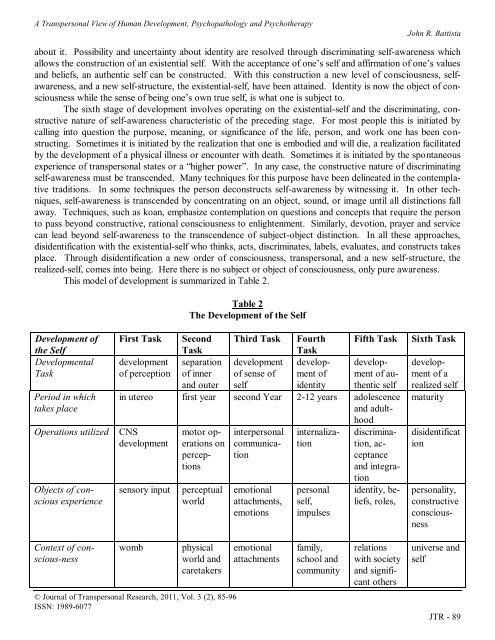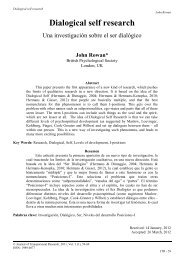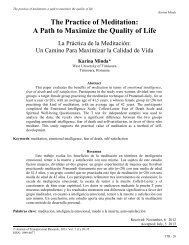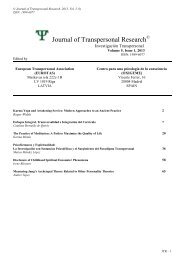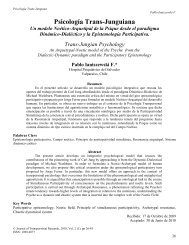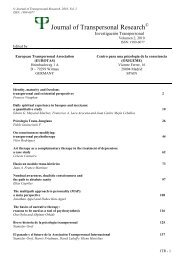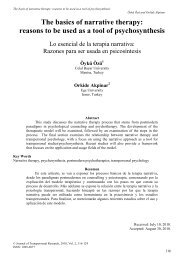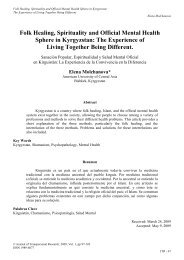John R. Battista - Journal of Transpersonal Research
John R. Battista - Journal of Transpersonal Research
John R. Battista - Journal of Transpersonal Research
Create successful ePaper yourself
Turn your PDF publications into a flip-book with our unique Google optimized e-Paper software.
A <strong>Transpersonal</strong> View <strong>of</strong> Human Development, Psychopathology and Psychotherapy<strong>John</strong> R. <strong>Battista</strong>about it. Possibility and uncertainty about identity are resolved through discriminating self-awareness whichallows the construction <strong>of</strong> an existential self. With the acceptance <strong>of</strong> one’s self and affirmation <strong>of</strong> one’s valuesand beliefs, an authentic self can be constructed. With this construction a new level <strong>of</strong> consciousness, selfawareness,and a new self-structure, the existential-self, have been attained. Identity is now the object <strong>of</strong> consciousnesswhile the sense <strong>of</strong> being one’s own true self, is what one is subject to.The sixth stage <strong>of</strong> development involves operating on the existential-self and the discriminating, constructivenature <strong>of</strong> self-awareness characteristic <strong>of</strong> the preceding stage. For most people this is initiated bycalling into question the purpose, meaning, or significance <strong>of</strong> the life, person, and work one has been constructing.Sometimes it is initiated by the realization that one is embodied and will die, a realization facilitatedby the development <strong>of</strong> a physical illness or encounter with death. Sometimes it is initiated by the spontaneousexperience <strong>of</strong> transpersonal states or a “higher power”. In any case, the constructive nature <strong>of</strong> discriminatingself-awareness must be transcended. Many techniques for this purpose have been delineated in the contemplativetraditions. In some techniques the person deconstructs self-awareness by witnessing it. In other techniques,self-awareness is transcended by concentrating on an object, sound, or image until all distinctions fallaway. Techniques, such as koan, emphasize contemplation on questions and concepts that require the personto pass beyond constructive, rational consciousness to enlightenment. Similarly, devotion, prayer and servicecan lead beyond self-awareness to the transcendence <strong>of</strong> subject-object distinction. In all these approaches,disidentification with the existential-self who thinks, acts, discriminates, labels, evaluates, and constructs takesplace. Through disidentification a new order <strong>of</strong> consciousness, transpersonal, and a new self-structure, therealized-self, comes into being. Here there is no subject or object <strong>of</strong> consciousness, only pure awareness.This model <strong>of</strong> development is summarized in Table 2.Table 2The Development <strong>of</strong> the SelfDevelopment <strong>of</strong>the SelfDevelopmentalTaskPeriod in whichtakes placeOperations utilizedObjects <strong>of</strong> consciousexperienceFirst Task SecondTaskThird Task FourthTaskFifth Taskdevelopment separation development developmentdevelop-<strong>of</strong> perception <strong>of</strong> inner <strong>of</strong> sense <strong>of</strong><strong>of</strong> ment <strong>of</strong> au-and outer selfidentity thentic selfin utereo first year second Year 2-12 years adolescenceand adulthoodCNSdevelopmentsensory inputmotor operationsonperceptionsperceptualworldemotionalattachments,emotionspersonalself,impulsesinterpersonalcommunicationinternalizationdiscrimination,acceptanceand integrationidentity, beliefs,roles,Sixth Taskdevelopment<strong>of</strong> arealized selfmaturitydisidentificationpersonality,constructiveconsciousnessContext <strong>of</strong> conscious-nesswombphysicalworld andcaretakersemotionalattachmentsfamily,school andcommunityrelationswith societyand significantothersuniverse andself© <strong>Journal</strong> <strong>of</strong> <strong>Transpersonal</strong> <strong>Research</strong>, 2011, Vol. 3 (2), 85-96ISSN: 1989-6077JTR - 89


